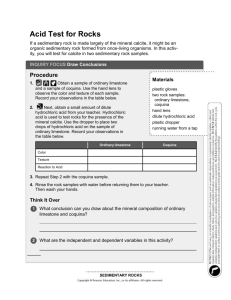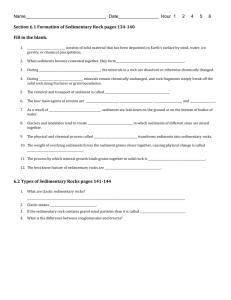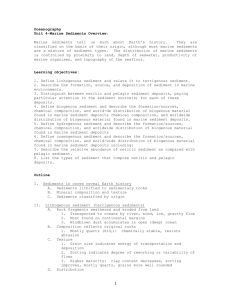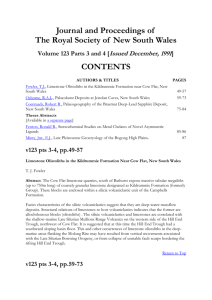Name:
advertisement
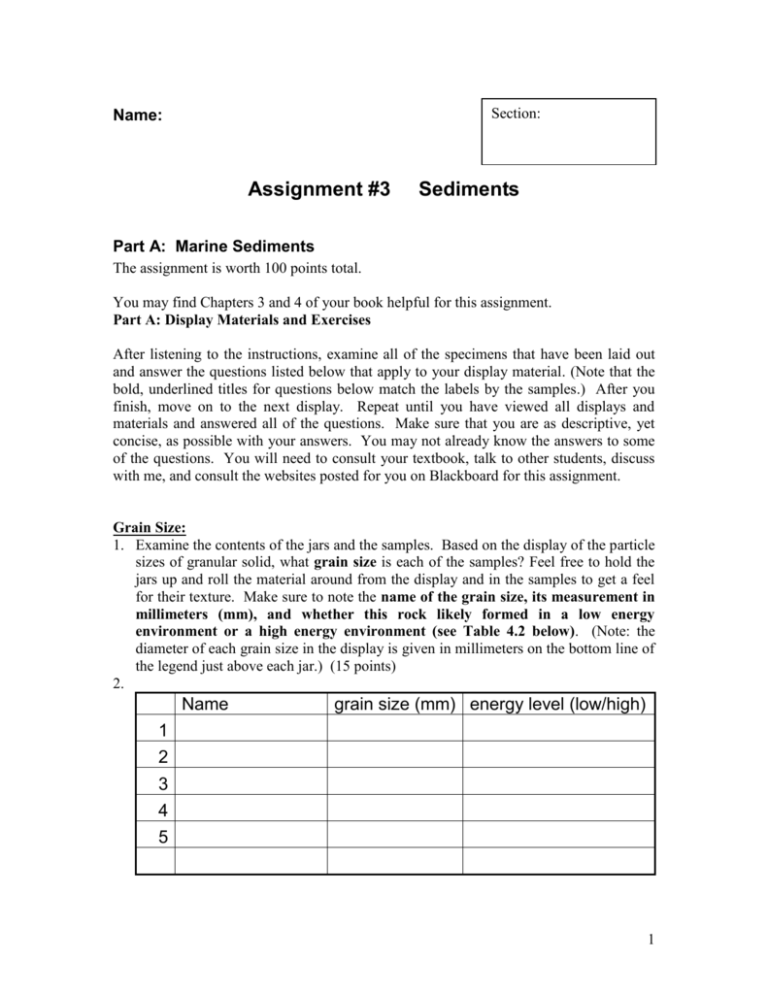
Section: Name: Assignment #3 Sediments Part A: Marine Sediments The assignment is worth 100 points total. You may find Chapters 3 and 4 of your book helpful for this assignment. Part A: Display Materials and Exercises After listening to the instructions, examine all of the specimens that have been laid out and answer the questions listed below that apply to your display material. (Note that the bold, underlined titles for questions below match the labels by the samples.) After you finish, move on to the next display. Repeat until you have viewed all displays and materials and answered all of the questions. Make sure that you are as descriptive, yet concise, as possible with your answers. You may not already know the answers to some of the questions. You will need to consult your textbook, talk to other students, discuss with me, and consult the websites posted for you on Blackboard for this assignment. Grain Size: 1. Examine the contents of the jars and the samples. Based on the display of the particle sizes of granular solid, what grain size is each of the samples? Feel free to hold the jars up and roll the material around from the display and in the samples to get a feel for their texture. Make sure to note the name of the grain size, its measurement in millimeters (mm), and whether this rock likely formed in a low energy environment or a high energy environment (see Table 4.2 below). (Note: the diameter of each grain size in the display is given in millimeters on the bottom line of the legend just above each jar.) (15 points) 2. Name grain size (mm) energy level (low/high) 1 2 3 4 5 1 Note that table above has been decreased in size so the scale is inaccurate. Use a ruler to see true millimeters. Also, answer above questions based on the size ranges shown on the jars, not this table. This table will guide you in determining the energy level. Sedimentary Rocks: 3. Look at all of the sedimentary rocks. Some of them have clear strata or layers. What is this feature a result of? (7 points) 4. What is sandstone? Pick up a piece of it, touch it, and think about your answer. How do you think it might form? (7 points) 5. Look at a piece of granite and compare it to a sedimentary rock. How are they different? (7 points) Conglomerates: 6. Describe a conglomerate rock. Is this rock formed in a high energy or low energy environment? (7 points) 2 7. Sugar cube in the jar: Place three cubes of sugar in the closed container and shake for 30 seconds. What happens to the cubes of sugar? If you have a sedimentary rock with rounded pieces in it (conglomerate) and one with sharp-edged pieces (breccia), what can you say was different about the way the two rocks formed? How does this relate to the sugar cubes?(7 points) Limestone and Coquina: Limestone is a sedimentary rock composed largely of the mineral calcite (calcium carbonate: CaCO3). Limestone also often contains variable amounts of silica, clay, silt and sand. The primary source of the calcite in limestone is marine organisms. These organisms secrete shells (or tests) that settle out of the water column and are deposited on ocean floors as pelagic ooze. The compacted and cemented deposits become lithofied over time and become a rock called limestone. When these deposits are poorly consolidated pieces of coral or shells the type of limestone formed is called coquina. 8. Look at the coquina and limestone samples. Describe each of them below. (3 points) 9. What happens when you put a drop of hydrochloric acid on these rocks? Why does this happen? (3 points) 3 Manganese Nodules: 10. Describe the manganese modules below. (4 points) 11. Refer to Chapter 4 to answer the following (10 points): a) What is hydrogenous sediment? b) Is hydrogenous sediment as abundant on the seafloor as biogenous sediment? c) What is lithogenous sediment? d) If manganese nodules accumulate so slowly, why aren’t they buried by sediment? e) What is a tektite? 4 Part B: In questions 1-3, put your answer in normalized scientific notation with two significant digits. Don’t forget the units! Always show your work!!! 1. Off the coast of Massachusetts there are deposits of neritic sediments. If the sedimentation rate here is 10 cm/1000 yr, how long does it take to deposit 50 meters of sediment in this part of the Atlantic? (5 points) 2. Farther off shore in the North Atlantic, are deposits of ooze, with sedimentation rates of 5 cm/1000 yr. How long would it take 50 meters of this sediment to be deposited? (5 points) 3. Suppose you found a deposit of red clay 100 meters thick in the central Pacific. If the sedimentation rate for the clay is 0.1 cm/1000 yr., how long would it take to deposit the 100 meters of sediment? (5 points) 5 4. Distributions and accumulation rates of biogenic oozes in oceanic sediments depend on which factors? Mark the factors as true (they do affect distribution and accumulation rates), or false (they do not have a significant effect on these rates). (5 points) rates of production of biogenic particles in the surface waters_____ dissolution rates of those particles in the water column and after they reach the bottom____ rate of sea floor spreading of the closest ocean ridge_____ rates of dilution by terrigenous sediments_____ rates of subduction_____ 5. Circle the correct word or phrase that should be used below. (The two options for each are underlined and separated with a slash). (10 points) From Australia to Chile one travels from a near-shore environment, over an abyssal plain, over oceanic trenches and eventually back to a near-shore environment; therefore, the sedimentation rate changes because different types of deposits are found in different environments, and these deposits accumulate at different rates. Just off the coast of continents, it is most common to find pelagic/lithogenous deposits that can accumulate fairly quickly (turbidity currents, etc). These near-continent deposits can also be classified as neritic/basaltic. Further off shore as one travels from Australia to Chile, one would come across oozes and clays. These deposits accumulate more slowly/quickly than near-shore sediments. Things such as rates of production of biogenic particles, dissolution rates and rates of turbidity/dilution can affect the rate of accumulation of biogenic oozes. The accumulation rates of other deposits vary as well and are usually slower in the middle of the oceans. But as you move closer to Chile, accumulation rates begin to be very high near the bottom of trenches in the subduction zone, due to the gentle/steep topography. 6


